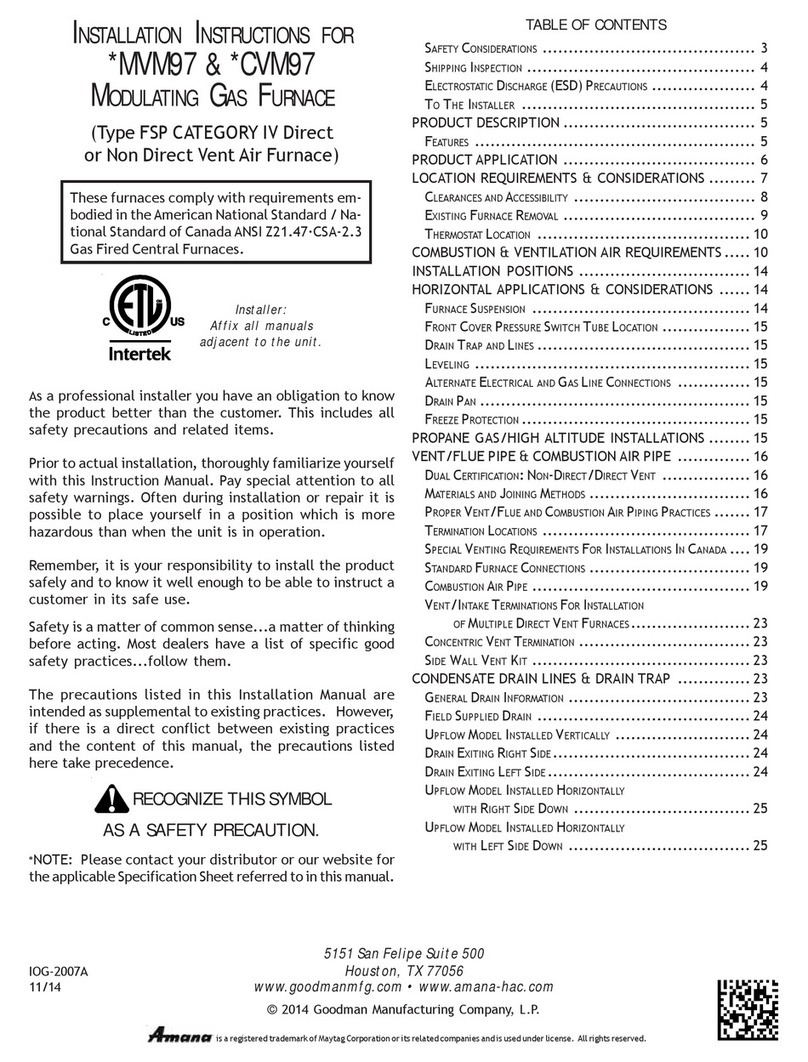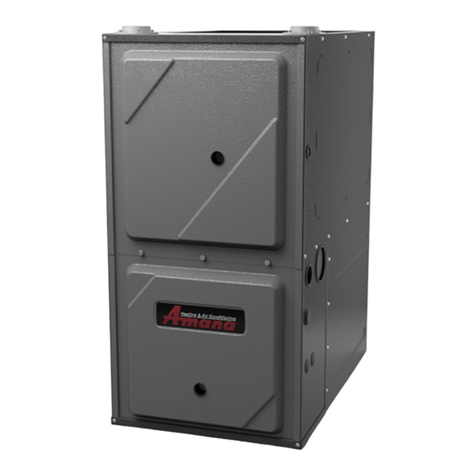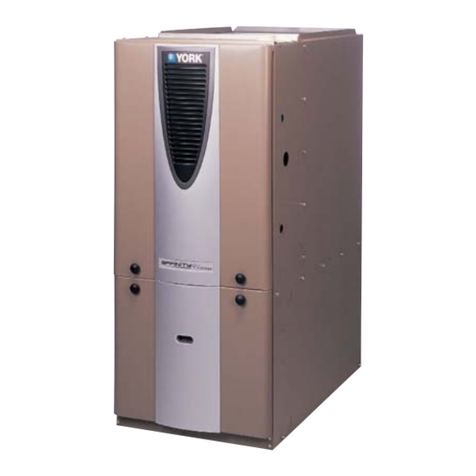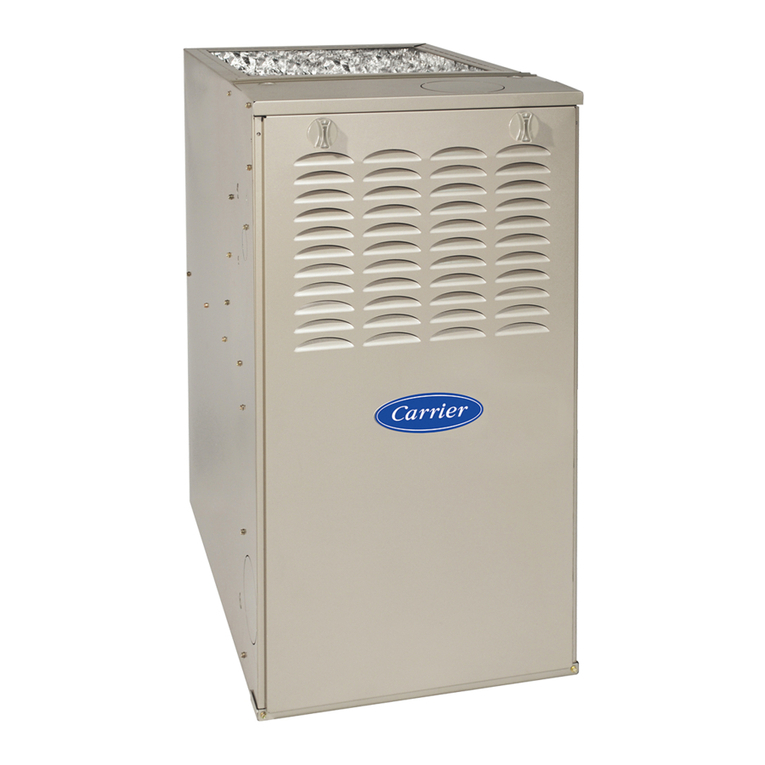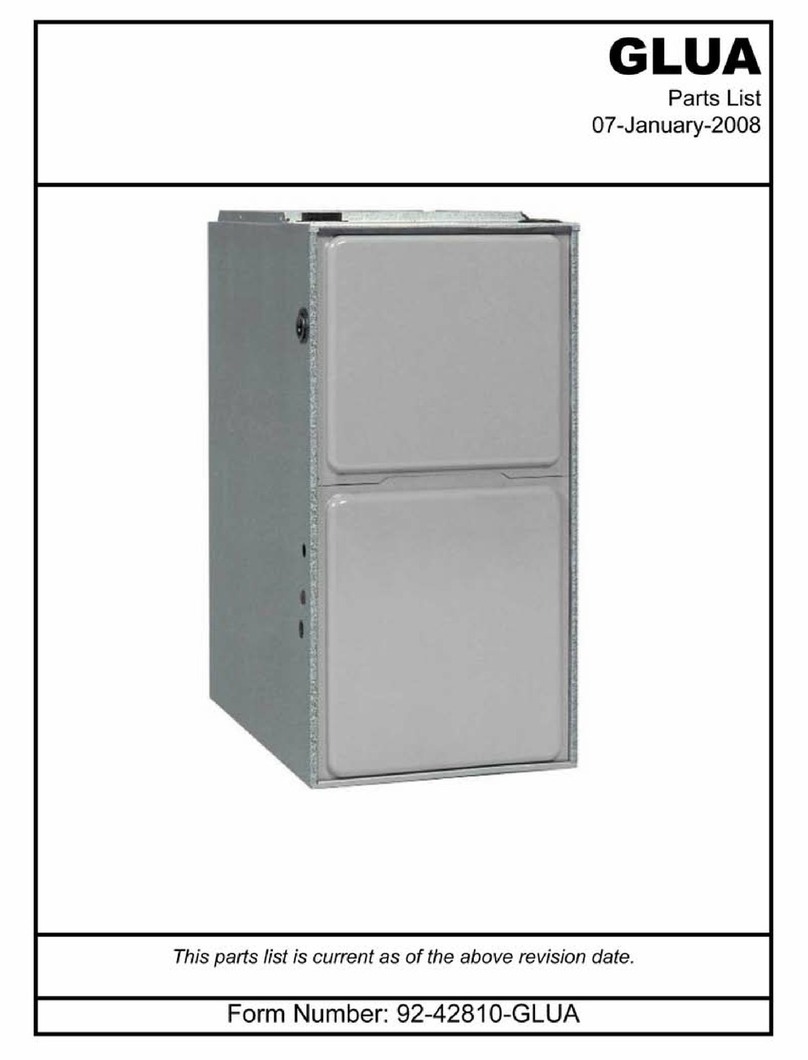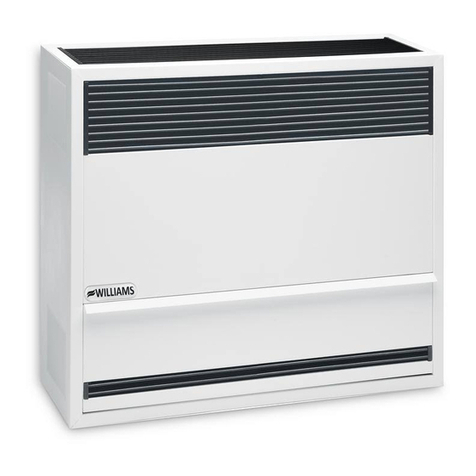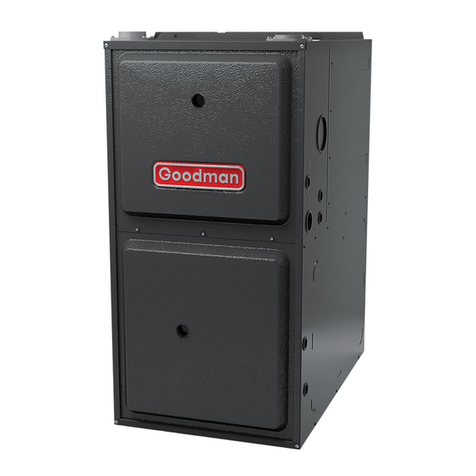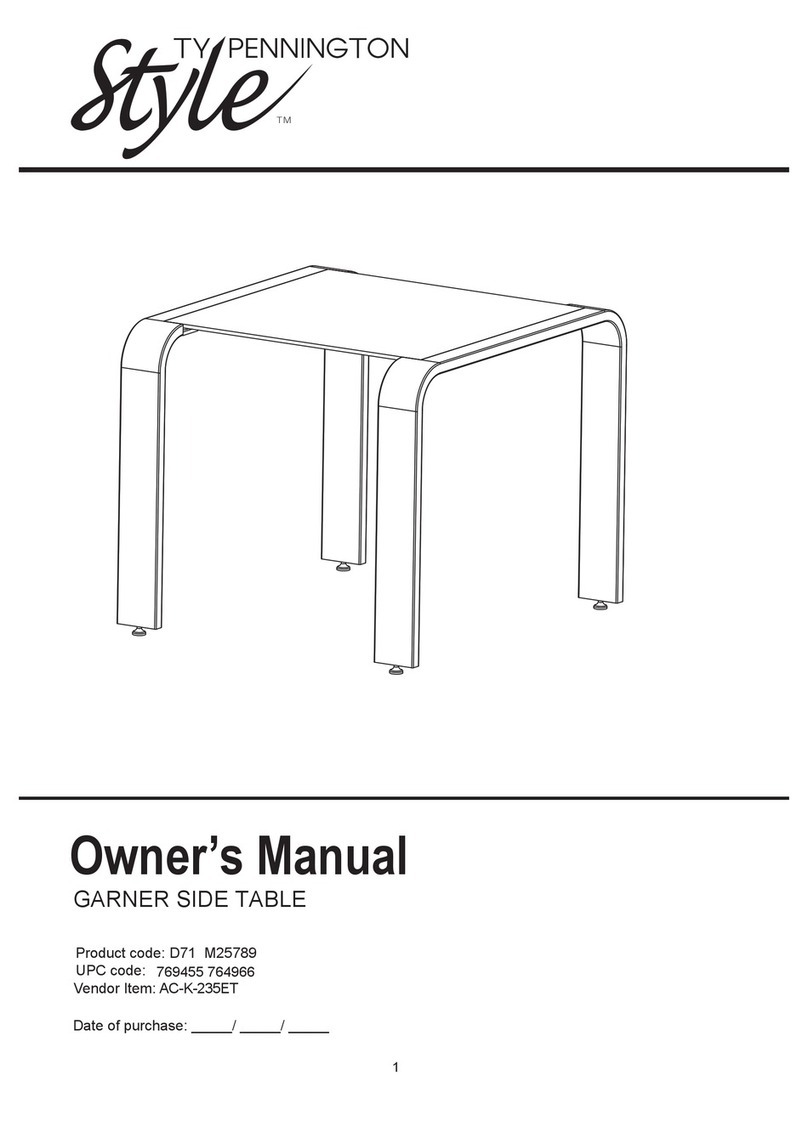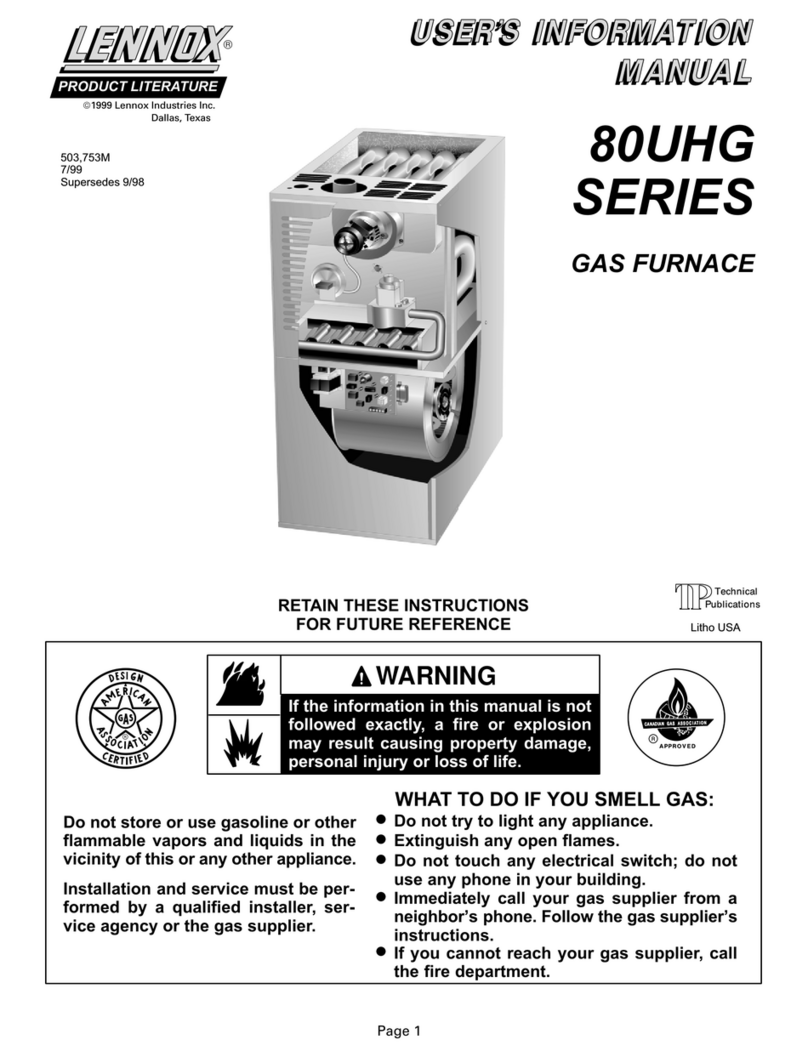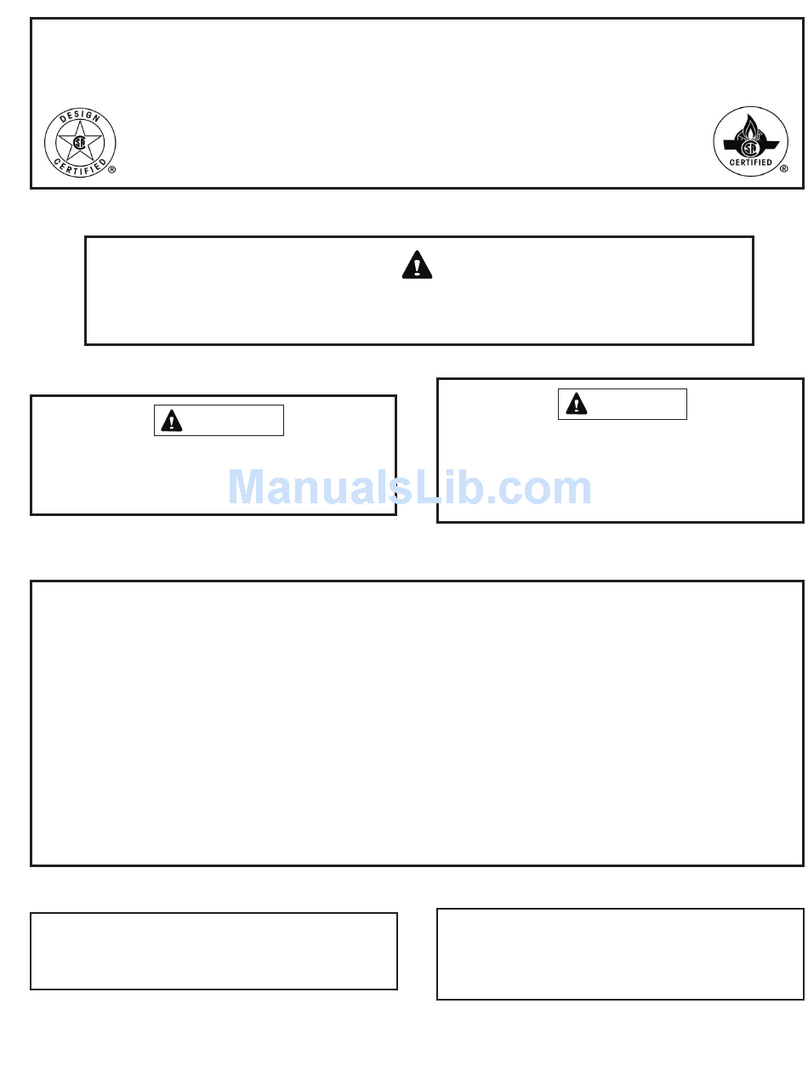Intertek MES80 User manual

5151 San Felipe Suite 500 • Houston, TX 77056
www.goodmanmfg.com • www.amana-hac.com
©2019 Goodman Manufacturing Company, L.P.
ATTENTION INSTALLING PERSONNEL
As a professional installer, you have an obligation to know
the product better than the customer. This includes all safety
precautions and related items.
Prior to actual installation, thoroughly familiarize yourself
with this Instruction Manual. Pay special attention to all
safety warnings. Often during installation or repair, it is
possible to place yourself in a position which is more
hazardous than when the unit is in operation.
Remember, it is your responsibility to install the product
safely and to know it well enough to be able to instruct a
customer in its safe use.
Safety is a matter of common sense...a matter of thinking
before acting. Most dealers have a list of specic, good
safety practices...follow them.
The precautions listed in this Installation Manual are
intended as supplemental to existing practices. However,
if there is a direct conict between existing practices and
the content of this manual, the precautions listed here take
precedence.
Installer: Ax all manuals
adjacent to the unit.
These furnaces comply with requirements embodied in the
American Naonal Standard/Naonal Standard of Canada
ANSI Z21.47·CSA-2.3 Gas Fired Central Furnaces.
IOG-2019B
10/2019
CATEGORY I CATÉGORIE I
is a registered trademark of Maytag Corporaon or its related companies and is used under license. All rights reserved.
TABLE OF CONTENTS
SAFETY CONSIDERATIONS....................................................... 3
Addional Safety Consideraons ...................................... 5
Shipping Inspecon........................................................... 5
Electrostac Discharge (ESD) Precauons......................... 6
To The Installer.................................................................. 6
PRODUCT APPLICATION........................................................... 6
LOCATION REQUIREMENTS AND CONSIDERATIONS................ 7
Clearances and Accessibility.............................................. 8
Installaon Posions ......................................................... 8
Venng For Horizontal Le Or Right Installaons ............. 8
Horizontal Installaon ....................................................... 8
Furnace Suspension .......................................................... 9
Exisng Furnace Removal.................................................. 9
Thermostat Locaon ....................................................... 10
COMBUSTION AND VENTILATION AIR REQUIREMENTS ........ 10
CATEGORY I VENTING (VERTICAL VENTING).......................... 10
EXTERIOR MASONRY CHIMNEYS (CAT. I FURNACES ONLY).... 11
Checklist Summary.......................................................... 11
Check 1 - Proper chimney terminaon........................... 11
Check 2 - Any Solid or Liquid Fuel Appliances
Vented into this Chimney Channel................... 12
Check 3 - Chimney Crown Condion .............................. 12
Check 4 - Debris in Cleanout ........................................... 12
Check 5 - Liner Condion ................................................ 12
Check 6 - Diluon Air ...................................................... 13
Check 7 - Complete the Installaon ............................... 13
Fix 1 - Liner Terminaon.................................................. 13
Fix 2 -Change Venng Arrangements .............................. 13
Fix 3 - Rebuild the Crown ................................................ 13
Fix 4 - Relining ................................................................. 13
RECOGNIZE THIS SYMBOL
AS A SAFETY PRECAUTION
: Please contact your distributor or our website listed below
for the applicable Specicaon Sheet referred to in this manual.
Only personnel that have been trained to install, adjust, service
or repair (hereinafter, “service”) the equipment specified in
this manual should service the equipment. The manufacturer
will not be responsible for any injury or property damage
arising from improper service or service procedures. If you
service this unit, you assume responsibility for any injury or
property damage which may result. In addition, in jurisdictions
that require one or more licenses to service the equipment
specified in this manual, only licensed personnel should service
the equipment. Improper installation, adjustment, servicing or
repair of the equipment specified in this manual, or attempting
to install, adjust, service or repair the equipment specified in
this manual without proper training may result in product
damage, property damage, personal injury or death.
Cancer and Reproductive Harm -
www.P65Warnings.ca.gov
PROP 65 WARNING
FOR CALIFORNIA CONSUMERS
0140M00517-A

2
IMPORTANT NOTE: This unit is designed to meet the NOX
requirement of 14Ng/J maximum as required by the South
Coast Air Quality Management District and the San Joaquin
Valley Air Pollution Control District, both in the State of Cal-
ifornia, and is intended for installation in those districts only.
This unit has a Control System that compensates for certain
installation and environmental conditions. This unit must:
• Be properly installed, operated, and maintained per
the instructions.
• Be serviced only by properly trained Service
Technicians.
This unit is not approved for use with gasses other than
Natural Gas.
Units that are not installed, maintained, or operated properly
may result in “noisy” operation during the Heating Cycle. If
this unit is making unusual or objectionable noises during the
Heating Cycle, turn the heat o at the thermostat and contact
a qualied Service organization right away.
ELECTRICAL CONNECTIONS ................................................... 14
Wiring Harness................................................................ 14
120 Volt Line Connecons............................................... 15
Juncon Box Relocaon .................................................. 15
24 Volt Thermostat Wiring.............................................. 15
120 Volt Line Connecon of Accessories ........................ 16
Humidier and Electronic Air Cleaner............................. 16
Fossil Fuel Applicaons ................................................... 16
GAS SUPPLY AND PIPING ....................................................... 16
High Altude Derate ....................................................... 17
Gas Piping Connecons................................................... 17
Upow Installaons ........................................................ 18
Gas Piping Checks ........................................................... 18
CIRCULATING AIR AND FILTERS ............................................. 18
Ductwork - Air Flow......................................................... 18
Filters - Read This Secon Before
Installing The Return Air Ductwork ................................. 19
Upright Installaons........................................................ 19
Circulaon Air Filters....................................................... 19
Horizontal Installaons ................................................... 20
NORMAL SEQUENCE OF OPERATION .................................... 20
Power Up......................................................................... 20
Heang Mode ................................................................. 20
Cooling Mode.................................................................. 21
Fan Only Mode................................................................ 21
START-UP PROCEDURE AND ADJUSTMENT ........................... 21
Furnace Operaon .......................................................... 21
Furnace Start-up.............................................................. 21
Furnace Shutdown .......................................................... 22
Gas Supply Pressure Measurement ................................ 22
Gas Manifold Pressure
Measurement and Adjustment ....................................... 23
Gas Input Rate Measurement (Natural Gas Only)........... 23
Temperature Rise ............................................................ 24
Circulator Blower Fan Timing Adjustment....................... 24
OPERATIONAL CHECKS .......................................................... 25
Checking Duct Stac........................................................ 25
SAFETY CIRCUIT DESCRIPTION............................................... 25
General............................................................................ 25
Integrated Control Module ............................................. 25
Primary Limit................................................................... 25
Auxiliary Limit.................................................................. 26
Burner Temperature Switch ............................................ 26
Pressure Sensor............................................................... 26
Flame Sensor................................................................... 26
TROUBLESHOOTING .............................................................. 26
Electrostac Discharge (ESD) Precauons....................... 26
Diagnosc Chart.............................................................. 26
Fault Code Retrieval ........................................................ 26
Clear Fault Memory......................................................... 26
Reseng From Lockout................................................... 26
MAINTENANCE...................................................................... 27
Annual inspecon ........................................................... 27
Filters............................................................................... 27
Filter Maintenance.......................................................... 27
Filter Removal ................................................................. 27
Horizontal Unit Filter Removal ........................................ 27
Induced Dra and Circulator Blower Motors .................. 27
Flame Sensor (Qualied Servicer Only)........................... 27
Igniter (Qualied Servicer Only)...................................... 27
Burner ............................................................................. 28
Cleaning (Qualied Servicer Only) .................................. 28
BEFORE LEAVING AN INSTALLATION...................................... 28
REPAIR AND REPLACEMENT PARTS ....................................... 28
COMPONENT ID .................................................................... 29
TROUBLESHOOTING CHART .................................................. 30
BLOWER PERFORMANCE DATA.............................................. 33
WIRING DIAGRAM................................................................. 34
Adhere to the following warnings and cautions when install-
ing, adjusting, altering, servicing, or operating the furnace.
To ensure proper installation and operation, thoroughly read
this manual for specics pertaining to the installation and
application of this product.
This furnace is manufactured for use with natural gas only.
Install this furnace only in a location and position as specied in
LOCATION REQUIREMENTS & CONSIDERATIONS section
and INSTALLATION POSITIONS section of this manual.
Provide adequate combustion and ventilation air to the fur-
nace as specied in COMBUSTION & VENTILATION AIR
REQUIREMENTS section of this manual.
Combustion products must be discharged to the outdoors.
Connect this furnace to an approved vent system only, as
specied in CATEGORY 1 VENTING section of this manual.
Never test for gas leaks with an open ame. Use a commercial-
ly available soap solution made specically for the detection of
leaks to check all connections, as specied in GAS SUPPLY
AND PIPING section of this manual.

3
Always install a furnace to operate within the furnace’s in-
tended temperature-rise range with a duct system which has
external static pressure within the allowable range, as speci-
ed on the furnace rating plate and OPERATIONAL CHECKS
section of these instructions.
When a furnace is installed so that supply ducts carry air cir-
culated by the furnace to areas outside the space containing
the furnace, the return air shall also be handled by duct(s)
sealed to the furnace casing and terminating outside the space
containing the furnace.
A gas-red furnace for installation in a residential garage must
be installed as specied in the LOCATION REQUIREMENTS
AND CONSIDERATIONS section of this manual.
This furnace may be used as a construction site heater only if
certain conditions are met. These conditions are listed in the
PRODUCT APPLICATION section of this manual.
SERVICE
SERVICER
.
WARNING
AVERTISSEMENT
WARNING
Failure to follow the safety warnings exactly could result
in serious injury, death or property damage.
Never test for gas leaks with an open flame.
Use a commercially available soap solution made
specifically for the detection of leaks to check all
connections. A fire or explosion may result causing
property damage, personal injury or loss of life.
Si les consignes de sécurité ne sont pas suivies à la lettre,
cela peut entraîner la mort, de graves blessures ou des
dommages matériels.
Ne jamais vérifier la présence de fuites de gaz au moyen
d'une flamme nue. Vérifier tous les raccords en utilisant
une solution savonneuse commerciale conçue
spécialement pour la détection de fuites. Un incendie ou
une explosion risque de se produire, ce qui peut entraîner
la mort, des blessures ou des dommages matériels.
I
IS
.
D
O
NOT
STORE
OR
USE
GASOLINE
OR
OTHER
FLAMMABLE
VAPORS
AND
LIQUIDS
IN
THE
VICINITY
OF
THIS
OR
ANY
OTHER
APPLIANCE
.
D
O
NOT
TRY
TO
LIGHT
ANY
APPLIANCE
.
D
O
NOT
TOUCH
ANY
ELECTRICAL
SWITCH
;
DO
NOT
USE
ANY
PHONE
IN
YOUR
BUILDING
.
I
MMEDIATELY
CALL
YOUR
GAS
SUPPLIER
FROM
A
NEIGHBOR
’
S
PHONE
. F
OLLOW
THE
GAS
SUPPLIER
’
S
INSTRUCTIONS
.
I
F
YOU
CANNOT
REACH
YOUR
GAS
SUPPLIER
,
CALL
THE
FIRE
DEPARTMENT
.
I
NSTALLATION
AND
SERVICE
MUST
BE
PERFORMED
BY
A
QUALIFIED
INSTALLER
,
SERVICE
AGENCY
OR
THE
GAS
SUPPLIER
.
:
�
�
�
�
WARNING
BE
DEVICEISBE
BEDEVICEIS
BE
PIPESBE
BE
MBE
BE
BE
BE.
WARNING
S
.
WARNING
P
.
WARNING
BE
C
.
P
BE
PIPE
BE
.
WARNING

4
D
Failure To Follow The Steps Outlined Below For Each Appliance
Connected To The Venting System Being Placed Into Operation
Could Result In Carbon Monoxide Poisoning Or Death. The
Following Steps Shall Be Followed For Each Appliance Connected
To The Venting System Being Placed Into Operation, While All
Other Appliances Connected To The Venting System Are Not In
Operation:
1) Seal Any Unused Openings In The Venting System.
2) Inspect The Venting System For Proper Size And Horizontal
Pitch, As Required In The National Fuel Gas Code, Ansi
Z223.1/nfpa 54 Or The Natural Gas And Propane Installation Code,
Csa B149.1 And These Instructions. Determine That There Is No
Blockage Or Restriction, Leakage, Corrosion And Other
Deficiencies Which Could Cause An Unsafe Condition.
3) As Far As Practical, Close All Building Doors And Windows And
All Doors Between The Space In Which The Appliance(s)
Connected To The Venting System Are Located And Other Spaces
Of The Building.
4) Close Fireplace Dampers.
5) Turn On Clothes Dryers And Any Appliance Not Connected To
The Venting System. Turn On Any Exhaust Fans, Such As Range
Hoods And Bathroom Exhausts, So They Are Operating At
Maximum Speed. Do Not Operate A Summer Exhaust Fan.
6) Follow The Lighting Instructions. Place The Appliance Being
Inspected Into Operation. Adjust The Thermostat So Appliance Is
Operating Continuously.
7) Test For Spillage From Draft Hood Equipped Appliances At The
Draft Hood Relief Opening After 5 Minutes Of Main Burner
Operation. Use The Flame Of A Match Or Candle.
8) If Improper Venting Is Observed During Any Of The Above Tests,
The Venting System Must Be Corrected In Accordance With The
National Fuel Gas Code, Ansi Z223.1/nfpa 54 And/or Natural Gas
And Propane Installation Code, Csa B149.1.
9) After It Has Been Determined That Each Appliance Connected
To The Venting System Properly Vents When Tested As Outlined
Above, Return Doors, Windows, Exhaust Fans, Fireplace Dampers
And Any Other Gas-fired Burning Appliance To Their Previous
Conditions Of Use.
E
Si les étapes décrites ci-dessous ne sont pas suivies pour chacun
des appareils raccordés au système de ventilation au moment
de sa mise en marche, cela peut entraîner une intoxication au
monoxyde de carbone ou la mort. Les étapes suivantes doivent
être suivies pour chacun des appareils raccordés au système de
ventilation au moment de sa mise en marche, alors que tous les
autres appareils raccordés au système de ventilation ne sont
pas en marche:
1) Sceller toutes les ouvertures inutilisées du système de
ventilation.
2) Inspecter le système de ventilation afin de vérifier si la taille
et l’inclinaison par rapport à l’horizontale sont conformes aux
exigences du National Fuel Gas Code, ANSI Z223.1/NFPA 54 ou
du Code d’installation du gaz naturel et du propane, CSA B149.1
et à ces instructions. Vérifier qu’il n’y pas d’obstruction ou de
pourraient entraîner une situation dangereuse.
3) Si possible, fermer toutes les portes et fenêtres du bâtiment
ainsi que toutes les portes séparant l’endroit où se trouvent les
appareils raccordés au système de ventilation et less autres
zones du bâtiment.
4) Fermer le registre des foyers.
5) Mettre les sécheuses en marche ainsi que tous les autres
appareils qui ne sont pas raccordés au systéme de ventilation.
Mettre en marche tous les ventilateurs de tirage, comme celui
des hottes de cuisine et des salles de bains, et les régler à la
puissance maximale. Ne pas mettre en marche les ventilateurs
d’été.
6) Suivre les instructions d’allumage. Mettre en marche
l’appareil soumis à l’inspection. Régler le thermostat de manièr
à ce que l’appareil fonctionne en continu.
7) Vérifier la présence de fuite au niveau de l’ouverture du
coupe-tirage des appareils qui en sont dotés après 5 minutes de
fontionnement du brûleur principal. Utiliser la flamme d’une
allumette ou d’une bougie.
8) Si un problème de ventilation est observé pendant l’un des
essaid décrits ci-dessus, des correctifs doivent être apportés au
système de ventilation conformé National Fuel Gas Code, Ansi
Z223.1/nfpa 54 And/or Natural Gas And Propane Installation
Code, Csa B149.1.
9) Une fois qu’il été déterminé que chaque appareil raccordé au
système de ventilation fontionne correctement au moyen des
essais décrits ci-dessus, les portes, les fenêtres, les ventilateurs,
les registres de foyer et tous les autres appareils de combustion
alimentés au gaz doivent être remis dans leur état initial.

5
• This furnace is approved for Category I Venting only.
• Provisions must be made for venting combustion
products outdoors through a proper venting system.
The length of ue pipe could be a limiting factor in
locating the furnace.
All units are securely packed in shipping containers tested ac-
cording to International Safe Transit Association specications.
The carton must be checked upon arrival for external damage.
If damage is found, a request for inspection by carrier’s agent
must be made in writing immediately.
The furnace must be carefully inspected on arrival for damage
and bolts or screws which may have come loose in transit. In
the event of damage the consignee should:
1. Make a notation on delivery receipt of any visible
damage to shipment or container.
2. Notify carrier promptly and request an inspection.
3. With concealed damage, carrier must be notied as
soon as possible - preferably within ve days.
4. File the claim with the following support documents
within a nine month statute of limitations.
• Original or certied copy of the Bill of Lading, or
indemnity bond.
• Original paid freight bill or indemnity in lieu thereof.
• Original or certied copy of the invoice, showing trade
and other discounts or reductions.
• Copy of the inspection report issued by carrier’s
representative at the time damage is reported to
carrier.
The carrier is responsible for making prompt inspection of
damage and for a thorough investigation of each claim. The
distributor or manufacturer will not accept claims from dealers
for transportation damage.
NOTE: Discharge your body’s static electricity before touching
unit. An electrostatic discharge can adversely aect electrical
components.
Use the following precautions during furnace installation
and servicing to protect the integrated control module from
damage. By putting the furnace, the control, and the person
at the same electrostatic potential, these steps will help
avoid exposing the integrated control module to electrostatic
discharge. This procedure is applicable to both installed and
non-installed (ungrounded) furnaces.
1. Disconnect all power to the furnace. Do not touch the
integrated control module or any wire connected to the
control prior to discharging your body’s electrostatic
charge to ground.
2. Firmly touch a clean, unpainted, metal surface of the
furnaces near the control. Any tools held in a person’s
hand during grounding will be discharged.
3. Service integrated control module or connecting
wiring following the discharge process in step 2. Use
caution not to recharge your body with static electricity;
(i.e., do not move or shue your feet, do not touch
ungrounded objects, etc.). If you come in contact with
an ungrounded object, repeat step 2 before touching
control or wires.
4. Discharge your body to ground before removing a new
control from its container. Follow steps 1 through 3 if
installing the control on a furnace. Return any old or
new controls to their containers before touching any
ungrounded object.

6
Before installing this unit, please read this manual thoroughly
to familiarize yourself with specic items which must be ad-
hered to, including but not limited to: unit maximum external
static pressure, gas pressures, BTU input rating, proper elec-
trical connections, circulating air temperature rise, minimum or
maximum CFM, and motor speed connections, and venting.
These furnaces are designed for Category I venting only.
.
WARNING
This furnace is primarily designed for residential home-heating
applications. It is NOT designed or certied for use in mobile
homes, trailers or recreational vehicles. Neither is it designed
or certied for outdoor applications. The furnace must be
installed indoors (i.e., attic space, crawl space, or garage area
provided the garage area is enclosed with an operating door).
This furnace can be used in the following non-industrial com-
mercial applications:
In such applications, the furnace must be installed with the
following stipulations:
• It must be installed per the installation instructions
provided and per local and national codes.
• It must be installed indoors in a building constructed
on site.
• It must be part of a ducted system and not used in a
free air delivery application.
• It must not be used as a “make-up” air unit.
• All other warranty exclusions and restrictions apply.
This furnace may be used as a construction site heater ONLY
if the following conditions are met:
• The vent system is permanently installed per these
installation instructions.
• A room thermostat is used to control the furnace. Fixed
jumpers that provide continuous heating CANNOT be
used and can cause long term equipment damage.
Bi-metal thermostats, or any thermostat aected by
vibration must not be used during construction.
• Return air ducts are provided and sealed to the
furnace.
• A return air temperature range between 60°F (16°C)
and 80°F (27°C) is maintained.
• Air lters are installed in the system and replaced
daily during construction and upon completion of
construction.
• The input rate and temperature rise are set per the
furnace rating plate.
• 100% outside air must be used for combustion during
construction. Temporary ducting may be used to
supply outside air to the furnace for combustion – do
not connect this duct directly to the furnace. Size this
duct according to NFPA 54/ANSI Z223.1 section for
Combustion and Ventilation Air.
• The furnace heat exchanger, components, duct
system, air lters and evaporator coils are thoroughly
cleaned following nal construction clean up by a
qualied person.
• All furnace operating conditions (including ignition,
input rate, temperature rise and venting) are veried
by a qualied person according to these installation
instructions.
• Furnace doors must be in place on the furnace while
the furnace is operating in any mode.
Damage or repairs due to failure to comply with these re-
quirements are not covered under the warranty.
To ensure proper furnace operation, install, operate and
maintain the furnace in accordance with these installa-
and ordinances. In their absence, follow the latest edition
of the National Fuel Gas Code (NFPA 54/ANSI Z223.1), local
plumbing or waste water codes, and other applicable codes.
A copy of the National Fuel Gas Code (NFPA 54/ANSI Z223.1)
can be obtained from any of the following:
American National Standards Institute
25 West 43rd Street, 4th Floor
New York, NY 10036
National Fire Protection Association
1 Batterymarch Park
Quincy, MA 02169-7471
CSA International
8501 East Pleasant Valley
Cleveland, OH 44131
Additional helpful publications available from the NFPA are,
NFPA 90A - Installation of Air Conditioning and Ventilating
System and NFPA 90B - Warm Air Heating and Air Condi-
tioning System.
The rated heating capacity of the furnace should be greater
than or equal to the total heat loss of the area to be heated.
The total heat loss should be calculated by an approved
method or in accordance with “ASHRAE Guide” or “Manual
J-Load Calculations” published by the Air Conditioning Con-
tractors of America.

7
Location Requi
rements and Considerations
BE
.
WARNING
Follow the instructions listed below when selecting a furnace
location. Refer also to the guidelines provided in Combustion
and Ventilation Air Requirements.
• Centrally locate the furnace with respect to the
proposed or existing air distribution system.
• Ensure the temperature of the return air entering the
furnace is between 55°F and 100°F when the furnace
is heating.
• Provisions must be made for venting combustion
products outdoors through a proper venting system.
The length of ue pipe could be a limiting factor in
locating the furnace.
• Ensure adequate combustion air is available for the
furnace. Improper or insucient combustion air
can expose building occupants to gas combustion
products that could include carbon monoxide. Refer
to Combustion and Ventilation Air Requirements.
• The furnace must be level. If the furnace is to be set
on a oor that may become wet or damp at times,
the furnace should be supported above the oor on
a concrete base sized approximately 1-1/2” larger
than the base of the furnace.
• Ensure upow or horizontal furnaces are not installed
directly on carpeting, or any other combustible
material. The only combustible material allowed is
wood.
• Exposure to contaminated combustion air will result
in safety and performance-related problems. Do
not install the furnace where the combustion air is
exposed to the following substances:
permanent wave solutions
chlorinated waxes or cleaners
chlorine-based swimming pool chemicals
carbon tetrachloride
water softening chemicals
swiming pool chemicals
deicing salts or chemicals
halogen type refrigerants
printing inks
cleaning solutions (such as perchloroethylene)
paint removers
varnishes
hydrochloric acid
cements and glues
antistatic fabric softeners for clothes dryers
masonry acid washing materials
• If the furnace is used in connection with a cooling
unit, install the furnace upstream or in parallel with the
cooling unit coil. Premature heat exchanger failure
will result if the cooling unit coil is placed ahead of
the furnace.
For vertical (upflow) applications, the minimum
cooling coil width shall not be less than furnace width
minus 1”. Additionally, a coil installed above an upow
furnace may be the same width as the furnace or may
be one size larger than the furnace. Example: a “C”
width coil may be installed with a “B” width furnace.
For upow applications, the front of the coil and
furnace must face the same direction.
• If the furnace is installed in a residential garage,
position the furnace so that the burners and ignition
source are located not less than 18 inches above the
oor. Protect the furnace from physical damage by
vehicles.
• If the furnace is installed horizontally, ensure access
doors are not on the “up/top” or “down/bottom” side
of the furnace.
• Do not connect this furnace to a chimney ue that
serves a separate appliance designed to burn solid
fuel.
Top - 1"
Side
Clearance - 1"
Back - 0"
Front Clearance - 3"
• Adequate combustion/ventilation air must be supplied
to the closet. Improper or insucient combustion air
can expose building occupants to gas combustion
products that could include carbon monoxide.
• Furnace must be completely sealed to floor or
base. Combustion/ ventilation air supply pipes must
terminate 12” from top of closet and 12” from oor
of closet. DO NOT remove solid base plate for side
return.
• Return air ducts must be completely sealed to the
furnace and terminate outside the enclosure surfaces.

8
NOTE: For servicing or cleaning, a 24” front clearance is
required. Unit connections (electrical, ue and drain) may
necessitate greater clearances than the minimum clearanc-
es listed above. In all cases, accessibility clearance must
take precedence over clearances from the enclosure where
accessibility clearances are greater.
Clearance in accordance with local installation codes, the
requirements of the gas supplier and the manufacturer’s
installation instructions.
Dégaugement conforme aux codes d’installation locaux,
aux exigences du fournisseur de gaz et aux instructions
d’installation du fabricant.
TOP
B1-VENT SINGLE
(PLENUM)
1" 6" 1" 3" 0" 1"
VENT
SIDES
FRONT
BACK
Installations must adhere to the clearances to combustible
materials to which this furnace has been design certied. The
minimum clearance information for this furnace is provided
on the unit’s clearance label. These clearances must be
permanently maintained. Clearances must also accommodate
an installation’s gas, electrical, and drain line connections.
NOTE: In addition to the required clearances to combustible
materials, a minimum of 24” service clearance must be
available in front of the unit.
An upow furnace may be installed in an upright position or
horizontal on either the left or right side panel. Do not install
this furnace on its back. For vertically installed upow furnaces,
return air ductwork may be attached to the side panel(s) and/
or basepan. For horizontally installed upow furnaces, return
air ductwork must be attached to the basepan. Contact your
distributor for proper airow requirements and number of
required ductwork connections. Refer to, “Recommended
Installation Positions” for approproate installation positions,
ductwork connections, and resulting airow arrangements.
NOTE: Ductwork must never be attached to the back of the
furnace.
Always use a B-vent elbow to vent the ue from the top of the
furnace. The inducer cannot be turned due to limited space
in the cabinet. Do not attempt to do this.
Recomended Installarion Positions
For
horizontal installations,
insert the
#8 x 5/8 screw
from the
literature package.

9
Line contact to framing is permitted when installed in the
horizontal configuration. Line contact is defined as the
portion of the cabinet that is formed by the intersection of
the top and side. ACCESSIBILITY CLEARANCE, WHERE
GREATER, SHOULD TAKE PRECEDENCE OVER MINIMUM
FIRE PROTECTION CLEARANCE. A gas-red furnace for
installation in a residential garage must be installed so that the
ignition source and burners are located not less than eighteen
inches (18”) above the oor and is protected or located to
prevent physical damage by vehicles. A gas furnace must
not be installed directly on carpeting, tile, or other combustible
materials other than wood ooring.
If suspending the furnace from rafters or joist, use 3/8”
threaded rod and 2”x2”x3/8” angle iron as shown below. The
length of rod will depend on the application and the clearances
necessary.
Suspended Furnace
NOTE: When an existing furnace is removed from a venting
system serving other appliances, the venting system may be
too large to properly vent the remaining attached appliances.
The following vent testing procedure is reproduced from
the
The following steps shall be followed with each appliance
connected to the venting system placed in operation, while
any other appliances connected to the venting system are
not in operation:
a. Seal any unused openings in the venting system;
b. Inspect the venting system for proper size and
horizontal pitch, as required by the National Fuel Gas
Code, ANSI Z223.1 and these instructions. Determine
that there is no blockage or restriction, leakage,
corrosion and other deciencies which could cause
an unsafe condition;
c. In so far as practical, close all building doors and
windows and all doors between the space in which
the appliance(s) connected to the venting system
are located and other spaces of the building. Turn on
clothes dryers and any appliance not connected to
the venting system. Turn on any exhaust fans, such
as range hoods and bathroom exhausts, so they
shall operate at maximum speed. Do not operate a
summer exhaust fan. Close replace dampers;
d. Follow the lighting instructions. Place the appliance
being inspected in operation. Adjust thermostat so
appliance shall operate continuously;
e. Test for draft hood equipped appliance spillage at
the draft hood relief opening after 5 minutes of main
burner operation. Use the ame of a match or candle;
f. After it has been determined that each appliance
connected to the venting system properly vents when
tested as outlined above, return doors, windows,
exhaust fans, replace dampers and any other gas
burning appliance to their previous conditions of use;
g. If improper venting is observed during any of the
above tests, the common venting system must be
corrected.
Corrections must be in accordance with the latest edition of
the National Fuel Gas Code NFPA 54/ANSI Z223.1.
If resizing is required on any portion of the venting system,
use the appropriate table in the latest edition of the National
Fuel Gas Code ANSI Z223.1.
The thermostat should be placed approximately ve feet from
the oor on a vibration-free, inside wall in an area having good
air circulation. Do not install the thermostat where it may be
inuenced by any of the following:
• Drafts, or dead spots behind doors, in corners, or
under cabinets.
• Hot or cold air from registers.
• Radiant heat from the sun.
• Light xtures or other appliances.
• Radiant heat from a replace.
• Concealed hot or cold water pipes, or chimneys.
• Unconditioned areas behind the thermostat, such as
an outside wall.
Consult the instructions packaged with the thermostat for
mounting instructions and further precautions.

10
BE
BE
.
WARNING
Improved construction and additional insulation in buildings
have reduced heat loss by reducing air inltration and escape
around doors and windows. These changes have helped in
reducing heating/cooling costs but have created a problem
supplying combustion and ventilation air for gas red and
other fuel burning appliances. Appliances that pull air out
of the house (clothes dryers, exhaust fans, replaces, etc.)
increase the problem by starving appliances for air.
House depressurization can cause back drafting or improper
combustion of gas-red appliances, thereby exposing building
occupants to gas combustion products that could include
carbon monoxide.
If this furnace is to be installed in the same space with other
gas appliances, such as a water heater, ensure there is an
adequate supply of combustion and ventilation air for all
appliances. Refer to the latest edition of the National Fuel
Gas Code NFPA 54/ANSI Z223.1 or applicable provisions of
the local building codes for determining the combustion air
requirements for the appliances.
This furnace must use indoor air for combustion. It cannot be
installed as a direct vent (i.e., sealed combustion) furnace.
Most homes will require outside air be supplied to the furnace
area by means of ventilation grilles or ducts connecting directly
to the outdoors or spaces open to the outdoors such as attics
or crawl spaces. A furnace installed in a conned space (i.e.,
a closet or utility room) must have two ventilation openings
with a total minimum free area of 0.25 square inches per
1,000 BTU/hr of furnace input rating. Refer to Specication
Sheet applicable to your model for minimum clearances to
combustible surfaces. One of the ventilation openings must
be within 12” of the top; the other opening must be within 12”
of the bottom of the conned space. In a typical construction,
the clearance between the door and door frame is usually
adequate to satisfy this ventilation requirement.
BE
.
WARNING
Category I Venting is venting at a non-positive pressure. A
furnace vented as Category I is considered a fan-assisted
appliance and the vent system does not have to be “gas tight.”
NOTE: Single stage gas furnaces with induced draft blowers
draw products of combustion through a heat exchanger
allowing, in some instances, common venting with natural
draft appliances (i.e. water heaters). All installations must be
vented in accordance with the latest edition of the National
Fuel Gas Code NFPA 54/ANSI Z223.1 .
Note: The vertical height of the category 1 venting system
must be at least as great as the horizontal length of the vertical
system.
S
IS
.
WARNING
The minimum vent diameter for the Category I venting system
is as shown:
MINIMUM VENT
UPFLOW
40 4 Inch
60 4 Inch
80 4 Inch
MODEL
Under some conditions, larger vents than those shown above
may be required or allowed. When an existing furnace is
removed from a venting system serving other appliances, the
venting system may be too large to properly vent the remaining
attached appliances.

11
An exterior masonry chimney is dened as a “Masonry”
chimney exposed to the outdoors on one or more sides
below the roof line.” The ability to use a clay lined masonry
chimney depends on a parameter not associated with interior
chimneys. This variable is the geographic location of the
installation. Researchers have discovered that the winter
design temperatures have a direct impact on the suitability of
this type of venting. In most situations, the existing masonry
chimneys will require a properly sized metallic liner.
P
IS
IS
IS
BE
IS
IS
.
WARNING
Clay Tile Size: 8" x 8" x12"
(Each x 24" Length)
1/2" to 1" Air Space
Second Floor
Roof Line
Throat
Clean Out
Natural Draft
Water Heater
Water Heater
Vent Connector
F.A.F. Vent
Connector
Typical Multiple Flue Clay Tile Chimney
This checklist serves as a summary of the items to be checked
before venting an 80+ furnace into a masonry chimney. In
addition, we recommend that a qualied serviceman use this
checklist to perform a yearly inspection of the furnace venting
system.
This checklist is only a summary. For detailed information
on each of the procedures mentioned, see the paragraph
referenced with each item.
Proper Chimney
Termination?
(Check 1)
Chimney channel
free of solid and
liquid fuel
appliances?
(Check 2)
Change venting
arrangements
(Fix 2)
Crown in good
condition
(Check 3)
Rebuild crown
(Fix 3)
and/or Reline
(Fix 4)
Reline
(Fix 4)
Reline
(Fix 4)
Cleanout free of
debris?
(Check 4)
Liner in good
condition?
(Check 5)
Reline
(Fix 4)
Dilution air
available?
(Check 6)
Complete the
installation.
(Check 7)

12
Solid fuel appliances include replaces, wood stoves, coal
furnaces, and incinerators.
Liquid fuel appliances include oil furnaces, oil-red boilers and
oil-red water heaters.
Appliances which burn propane (sometimes referred to as LP
(liqueed petroleum)) gas are considered gas-red appliances.
Damage from condensate usually shows up rst in the crown.
If any of the following trouble signs are present, the condition
of the crown is not satisfactory:
a) Crown leaning
b) Bricks missing
c) Mortar missing
d) Tile liner cracked
e) No tile liner
f) Salt staining at mortar joints. (White stains, and mortar
becomes sandy and/or erodes.)
For problems a, b, or c, see Fix 3. If problems d, e, or f are
present, see Fix 4. IMPORTANT: It may be necessary to follow
both Fix 3 and Fix 4.
A cleanout (dropleg) must be present such that the upper edge
of the cleanout cover is at least 12 inches below the lower
edge of the lowest chimney inlet opening.
A chimney without a cleanout could become partially blocked
by debris. If no cleanout is present, the chimney must be
relined (Fix 4). Remove the cleanout cover, and examine
the cleanout for debris. If signicant amounts of any of the
following are found:
• Fuel oil residue
• Bricks
• Mortar or sand
• Pieces of the tile liner
• Rusted pieces of the metallic liner - reline the chimney
(Fix 4).
If a metal liner is present, it must be checked. It cannot be
assumed that all existing metal liners are correctly installed
and in good condition.
Remove the lowest existing vent connector, and examine
the inside of the elbow or tee at the base of the liner. A small
amount of soot may be considered acceptable, provided the
installer vacuums it away. If rusted pieces of the liner have
collected here, the metal liner must be removed and replaced
(Fix 4).
Next, gently tap the inside of the liner with a Phillips screw-
driver. If the screwdriver perforates the liner, or if the tapping
does not sound like metal hitting metal, the liner must be
removed and replaced (Fix 4).
A masonry chimney used as a vent for gas red equipment
must extend at least three feet above the highest point where it
passes through the roof. It must extend at least two feet higher
than any portion of a building within a horizontal distance of
10 feet. In addition, the chimney must terminate at least 3 feet
above any forced air inlet located within 10 feet. The chimney
must extend at least ve feet above the highest connected
equipment draft hood outlet or ue collar.
If the chimney does not meet these termination requirements,
but all other requirements in the checklist can be met, it may
be possible for a mason to extend the chimney. If this will not
be practical, see Fix 1.
Wall or
Parapet
2' Min.
2' Min.
3' Min.
10' or Less
10' or Less
2' Min.
3' Min.
More than 10’
Wall or
Parapet
NOTE: No Height
above parapet
required when distance
from walls or parapet is
more than 10 feet.
Chimney
3’ Min.
More than 10’
10’
2” Min.
3’ Min.
Chimney
Height above any
roof surface within
10 feet horizontally.
Ridge

13
If Checks 1 through 6 have been satisfactory, and the liner is
an acceptable size as determined by the tables in the latest
edition of the National Fuel Gas Code NFPA 54/ANSI Z223.1,
then the clay tile liner can probably be used as a vent for the
gas appliances. However, the installer must keep in mind the
following factors which may render the tile liner unsuitable
for use as a vent:
• Extremely cold weather
• Long vent connectors
• Masonry chimneys with no air gap between the liner
and the bricks. (In practice, this can be dicult to
detect.)
• Exterior chimneys (The tables in National Fuel Gas
Code NFPA 54/ANSI Z223.1 - latest edition)
If, in the judgment of the local gas utility, installer, and/or local
codes; one or more of the above factors is likely to present a
problem, the chimney must be relined (Fix 4).
Any cap or roof assembly used with a liner must be approved
by the liner manufacturer for such use. The liner and cap/roof
assembly must then terminate above the roof in accordance
with the manufacturer’s instructions.
In some cases, a shorter extension above the roof may be
possible with a liner than would be required with a masonry
chimney.
For further information on relining, see Fix 4.
If the masonry chimney has more than one channel, it may be
possible to vent the gas appliances into one channel and vent
the solid or liquid fuel appliance(s) into another channel(s).
Do not vent an 80+ Furnace inside of a metal liner with other
appliances vented outside the liner.
Alternatively, the homeowner may agree to discontinue use
of the replace (solid fuel appliance). If so, the tile liner must
be cleaned to remove creosote buildup. The replace opening
must then be permanently sealed.
If oil-red appliance(s) are being replaced by gas-red appli-
ance(s), the tile liner must rst be cleaned to remove the fuel
oil residue.
If none of the above options is practical, the furnace may need
to be vented vertically with a B Vent.
Under some conditions, a 90%+ furnace could be installed
rather than an 80% furnace. The 90%+ furnace can be vented
horizontally or vertically through PVC pipe.
If the chimney crown is damaged, a qualied mason must re-
pair it in accordance with nationally recognized building codes
or standards. One such standard which may be referenced is
the Standard for Chimneys, Fireplaces, Vents, and Solid Fuel
Burning Appliances, ANSI/NFPA 211.
Remember that all appliances must be vented inside the liner.
Venting one appliance inside the liner and another appliance
outside the liner is not acceptable.
Next, use a ashlight and small mirror to sight up the liner. B
vent must be supported so as to not come into direct contact
with the chimney walls or tile liner. If it is not, it can probably
be rehung so as to be acceptable. A thimble or re stop may
be helpful here.
Flexible liners should be hung straight or nearly straight. If it
is spiraled in the chimney and in good condition, it should be
rehung. To do this, break the top seal; pull up and cut o the
excess liner length, and ret the top seal. Use caution when
doing this, as the cut edges of exible liners may be sharp.
The surfaces of the liner must be physically sound. If gaps
or holes are present, the metal liner must be removed and
replaced (Fix 4). Finally, conrm that the metal liner is the
correct size for the appliances to be installed. Use the GAMA
tables and rules.
If a metal liner is not present, a clay tile liner must be present,
or the chimney must be lined (Fix 4).
Use a ashlight and small mirror at the cleanout or vent
connector to inspect the clay tile liner. If any of the following
problems are present:
• Tile sections misaligned
• Tile sections missing
• Gaps between tile sections
• Signs of condensate drainage at the cleanout or vent
connectors
• Mortar protruding from between tile sections
• Use of sewer pipe or drainage pipe rather than an
approved re clay tile reline the chimney (Fix 4).
Next, measure the size of the liner. It may be possible to do
this from the cleanout. The liner must be at least as large as
the minimum size established by the tables in in the latest
edition of the National Fuel Gas Code NFPA 54/ANSI Z223.1.
If the liner is too small or too large, then the chimney must
be relined (Fix 4).
If gas-red appliances are to be vented into a clay tile liner, a
source of dilution air is required.
Dilution air cannot be obtained through:
• Induced draft appliances
• Natural draft appliances with vent dampers
Sucient dilution air can ordinarily be obtained through the
draft hood of a natural draft appliance only if the appliance’s
vent connector does not include a vent damper. If dilution
air will not be available, the chimney must be relined (Fix 4).

14
in the chimney. (Poured insulation, either vermiculite or other
materials, is no longer recommended.) Insulation will need to
be added to the exible liner if:
• It is required by the liner manufacturer’s instructions.
• The previous liner was properly sized and installed,
and suered from condensation damage.
• It is required by your local building codes.
Even if none of those three conditions exist which require ad-
ditional liner insulation, the installer may wish to consider it if:
• The local climate is very cold.
• The chimney is very tall.
• The vent connectors used are very long or have a
large number of elbows.
• Local experience indicates that exible liners installed
without insulation are likely to have condensation
problems.
Insulation must be selected and installed in accordance with
the liner manufacturer’s instructions.
Finally, cap the chimney and terminate the liner in accordance
with the liner manufacturer’s instructions.
!
.
WARNING
.
CAUTION
!
BE
.
WARNING
The wiring harness is an integral part of this furnace. Field
alteration to comply with electrical codes should not be re-
quired. Wires are color coded for identication purposes.
Refer to the wiring diagram for wire routings. If any of the
original wire as supplied with the furnace must be replaced,
it must be replaced with wiring material having a temperature
rating of at least 105°C. Any replacement wiring must be a
copper conductor.
Relining options include B vent and exible liners.
If the chimney has diagonal osets, B vent probably cannot
be used.
If B vent is to be used, it must be supported adequately.
Supports (such as re stops or thimbles) must be used to
prevent the B vent from coming into direct contact with the tile
liner or chimney walls. Direct contact would result in higher
heat loss, with an increased possibility of poor venting system
performance.
It is not acceptable to vent one appliance inside the B vent
and other appliances outside. The excess space between the
B vent and the chimney walls must be covered at the top of
the chimney by a weatherproof, corrosion resistant ashing.
The B-vent should then be topped with a listed vent cap. The
listed vent cap will, when installed per the manufacturer’s in-
structions, prevent problems due to rain, birds, or wind eects.
A B-vent installed as described in this section is considered
to be an enclosed vent system, and the sizing tables in in the
latest edition of the National Fuel Gas Code NFPA 54/ANSI
Z223.1.
If a exible liner is to be used, it must be made of the proper
materials:
• For most residential applications, an aluminum liner
should be acceptable.
• If the combustion air supplied to the furnace will be
contaminated with compounds containing chlorine
or fluorine, a liner of AL 29-4C stainless steel
should be used. Common sources of chlorine and
uorine compounds include indoor swimming pools
and chlorine bleaches, paint strippers, adhesives,
paints, varnishes, sealers, waxes (which are not
yet dried) and solvents used during construction
and remodeling. Various commercial and industrial
processes may also be sources of chlorine/uorine
compounds.
• Heavier gauge 300 and 400 series stainless steel
liners were developed for use with oil or solid fuel
appliances. They are not suitable for use with gas-
red appliances. Flexible liners specically intended
and tested for gas applications are listed in the UL
“Gas and Oil Equipment Directory”. (UL Standard
1777).
For sizing of exible liners, see the tables in the latest edition
of the National Fuel Gas Code NFPA 54/ANSI Z223.1.
To install the liner, read and follow the liner manufacturer’s
instructions and your local codes. Excess liner length should
be pulled out of the chimney and cut o. Use caution when
doing this, as the cut edges of exible liners may be sharp.
Do not spiral excess liner inside of the chimney. Support the
liner as recommended by the liner manufacturer.
Some manufacturers of exible liners oer an insulation
sleeve designed to be added to the liner before it is installed

15
Before proceeding with electrical connections, ensure that
the supply voltage, frequency, and phase correspond to
that specied on the unit rating plate. Power supply to the
furnace must be NEC Class 1, and must comply with all ap-
plicable codes. The furnace must be electrically grounded
in accordance with local codes or, in their absence, with the
atest edition of The National Electric Code, ANSI NFPA 70.
Use a separate fused branch electrical circuit containing
properly sized wire, and fuse or circuit breaker. The fuse
or circuit breaker must be sized in accordance with the
maximum overcurrent protection specied on the unit rating
plate. An electrical disconnect must be provided at the
furnace location.
Line voltage wiring must enter into the junction box provided
with the furnace.
Line polarity must be observed when making eld connections.
Line voltage connections can be made through either the right
or left side panel. To relocate the junction box, follow the steps
shown in the Junction Box Relocation section.
E
BE
SE
.
WARNING
Line voltage connections can be made through either the
right or left side panel. The furnace is shipped congured
for a right side electrical connection. To make electrical
connections through the opposite side of the furnace, the
junction box must be relocated to the left side prior to making
electrical connections. To relocate the junction box, perform
the following steps.
.
WARNING
1. Remove both doors from the furnace.
2. Remove and save the screws holding the junction box
to the right side of the furnace.
3. Models that have the junction box located in the burner
compartment will need to move the junction box directly
over.
4. Attach the junction box to the left side of the furnace,
using the screws removed in step 2.
5. Check the location of the wiring. Conrm that it will
not be damaged by heat from the burners or by the
rotation of the fan. Also conrm that wiring location will
not interfere with l ter removal or other maintenance.
After the junction box is in the desired location, use washers
to connect eld-supplied conduit to the junction box in accor-
dance with NEC and local codes. Connect hot, neutral, and
ground wires as shown in the furnace wiring diagram. The
wires and ground screw are located in the furnace junction box.
Low voltage wires may be connected to the terminal strip.
IMPORTANT NOTE: To avoid possible equipment malfunc-
tion, route the low voltage wires to avoid interference with lter
removal or other maintenance.
!
BE
.
WARNING
To ensure proper unit grounding, the ground wire should run
from the furnace ground screw located inside the furnace
junction box all the way back to the electrical panel. NOTE:
Do not use gas piping as an electrical ground. To conrm
proper unit grounding, turn o the electrical power and perform
the following check.
1. Measure resistance between the neutral (white)
connection and the unpainted surface on the furnace.
2. Resistance should measure 10 ohms or less.
This furnace is equipped with a blower door interlock switch
which interrupts unit voltage when the blower door is opened
for servicing. Do not defeat this switch.
NOTE: Wire routing must not interfere with circulator blower
operation, lter removal, or routine maintenance.
Low voltage connections can be made through either the right
or left side panel. Thermostat wiring entrance holes are locat-
ed in the blower compartment. The following gure shows
connections for a “heat only” system and “heat/cool system”.
Furnace
Control Furnace
Control
Remote
Condensing
Unit
Heating
Room
Thermostat
Heating/Cooling
Room Thermostat
WW
This furnace is equipped with a 40 VA transformer to facilitate
use with most cooling equipment. Consult the wiring diagram,
located on the blower compartment door, for further details of
120 Volt and 24 Volt wiring.
A single-stage thermostat with only one heating stage is
needed to control this furnace.

16
!
.
WARNING
The furnace integrated control module is equipped with line
voltage accessory terminals for controlling power to an optional
eld-supplied humidier and/or electronic air cleaner.
The accessory load specications are as follows:
Electronic Air Cleaner 1.0 Amp maximum at 120 VAC
Humidifier 1.0 Amp maximum at 120 VAC
Turn OFF power to the furnace before installing any accesso-
ries. Follow the humidier and/or air cleaner manufacturers’
instructions for locating, mounting, grounding, and controlling
these accessories. Accessory wiring connections are to be
made through the 1/4” quick connect terminals provided on
the furnace integrated control module. The humidier and
electronic air cleaner hot terminal is identied as HUM and
EAC, the neutral terminal is identied as NEUTRAL. All eld
wiring must conform to applicable codes. Connections should
be made as shown in the following illustration.
R
Y C
Furnace Integrated
Control Module
Remote Condensing Unit
(Single-Stage Cooling)
R
Room
Thermostat
If it is necessary for the installer to supply additional line
voltage wiring to the inside of the furnace, the wiring must
conform to all local codes, and have a minimum temperature
rating of 105°C. All line voltage wire splices must be made
inside the furnace junction box.
The integrated control module single humidier terminal
(HUM) is energized with 120 volts whenever the induced
draft blower is energized. This terminal can also be used
to provide 120 volt power to a humidier transformer. The
remaining primary transformer wire would be connected to the
Line N on the control board. The integrated control module
electronic air cleaner terminals (EAC) are energized with 120
volts whenever the circulator blower is energized.
NOTE: Wiring routing must not interfere with circulator blower
operation, lter removal, or routine maintenance.
This furnace can be used in conjunction with a heat pump in
a fossil fuel application. A fossil fuel application refers to a
combined gas furnace and heat pump installation which uses
an outdoor temperature sensor to determine the most cost
ecient means of heating heat pump or gas furnace.
A heat pump thermostat with two stages of heat is required
to properly use a furnace in conjunction with a heat pump.
Refer to the fossil fuel kit installation instructions for additional
thermostat requirements.
Strictly follow the wiring guidelines in the fossil fuel kit
installation instructions. All furnace connections must be made
to the furnace integrated control module and the FURNACE
terminal strip on the fossil fuel control board.
The furnace rating plate includes the approved furnace gas
input rating and gas types. The furnace must be equipped to
operate on the type of gas applied.
CAUTION
BE
.
Inlet gas supply pressures must be maintained within the
ranges specied in the following table. The supply pressure
must be constant and available with all other household
gas red appliances operating. The minimum gas supply
pressure must be maintained to prevent unreliable ignition.
The maximum must not be exceeded to prevent unit overring
and damage to gas valve.
NOTE: Do not remove the gas valve inlet plug before the
gas line is installed. Replace if water or debris has been
introduced.
Natural Gas Minimum: 4.5" w.c. Maximum: 10.0" w.c.
INLET GAS SUPPLY PRESSURE
At all altitudes, the manifold pressure must be within 0.2 inches
w.c. of that listed in the Specication Sheet applicable to your
model for the fuel used. At all altitudes, the air temperature
rise must be within the range listed on the furnace nameplate.
IMPORTANT NOTE: The furnace, as shipped, requires no
change to run between 0-4500 feet. Do not attempt to change
the ring rate by changing orices or the manifold pressure.
This can cause poor combustion and equipment failure.
At all altitudes, the manifold pressure must be within 0.2
inches w.c. of that listed on the furnace nameplate. At all
altitudes the air temperature rise must be within the range
listed on the the Specication Sheet applicable to your
model for the fuel used.

17
Altitude Gas Kit
Manifold
P re ssu r e
P re ssu r e
Sensor
Natural
None
0 - 4500
None
3.0" w.c.
PIPE
.
I
WARNING
When sizing gas lines, be sure to include all appliances on the
same gas supply line and which will operate simultaneously.
The gas piping supplying the furnace must be properly sized
based on the gas ow required, specic gravity of the gas,
and length of the run. The gas line installation must comply
with local codes, or in their absence, with the latest edition of
the National Fuel Gas Code, NFPA 54/ANSI Z223.1.
Natural Gas Capacity of Pipe
Length of Nominal Black Pipe Size
Pipe in Feet 1/2" 3/4" 1" 1 1/4" 1 1/2"
10 132 278 520 1050 1600
20 92 190 350 730 1100
30 73 152 285 590 980
40 63 130 245 500 760
50 56 115 215 440 670
60 50 105 195 400 610
70 46 96 180 370 560
80 43 90 170 350 530
90 40 84 160 320 490
100 38 79 150 305 460
(Pressure 0.5 psig or less and pressure drop of 0.3" W.C.; Based on
0.60 Specif ic Gravity Gas)
CFH =
BTUH Furnace Input
Heating Value of Gas (BTU/Cubic Foot)
To connect the furnace to the building’s gas piping, the installer
must supply a ground joint union, drip leg, manual shuto
valve, and line and ttings to connect to gas valve. In some
cases, the installer may also need to supply a transition piece
from 1/2” pipe to a larger pipe size.
The following stipulations apply when connecting gas piping.
• Gas piping must be supported external to the furnace
cabinet so that the weight of the gas line does not
distort the burner rack, manifold or gas valve.
• Use black iron or steel pipe and ttings for the building
piping. Where possible, use new pipe that is properly
chamfered, reamed, and free of burrs and chips. If
old pipe is used, be sure it is clean and free of rust,
scale, burrs, chips, and old pipe joint compound.
• Use pipe joint compound on male threads ONLY.
Always use pipe joint compound (pipe dope) that
is APPROVED FOR ALL GASSES. DO NOT apply
compound to the rst two threads.
• Use ground joint unions.
• Install a drip leg to trap dirt and moisture before it can
enter the gas valve. The drip leg must be a minimum
of three inches long.
• Install a 1/8” NPT pipe plug tting, accessible for test
gage connection, immediately upstream of the gas
supply connection to the furnace.
• Always use a back-up wrench when making the
connection to the gas valve to keep it from turning.
The orientation of the gas valve connection is 374
in-lbs; excessive over-tightening may damage the
gas valve and/or gas manifold assembly.
• Install a manual shutoff valve between the gas
meter and unit within six feet of the unit. If a union
is installed, the union must be downstream of the
manual shuto valve, between the shuto valve and
the furnace.
• Tighten all joints securely.
• Protect connectors and semi-rigid tubing against
physical and thermal damage when installed. Ensure
aluminum-alloy tubing and connectors are coated to
protect against external corrosion when in contact
with masonry, plaster, or insulation, or subjected to
repeated wetting by liquids such as water (except rain
water), detergents, or sewage. The gas piping may
enter the left or right side of the furnace cabinet. The
installer must supply rigid pipe long enough to reach
the outside of the cabinet to seal the grommet cabinet
penetration. A semi-rigid connector to the gas piping
can be used outside the cabinet per local codes. 1/2”
NPT pipe and ttings are required. Model requires
one 90 deg elbow, one 2” nipple and additional nipple
to reach outside the cabinet. A semi-rigid connector
to the gas piping can be used outside the cabinet
per local codes. From the elbow, the length of pipe
and the ttings required will vary by the side chosen,
location of union and cabinet width. The union may
be placed inside or outside of the cabinet.
General Furnace Layout

18
EVER
.
WARNING
Duct systems and register sizes must be properly designed
for the CFM and external static pressure rating of the
furnace. Ductwork should be designed in accordance with
the recommended methods of “Air Conditioning Contractors
of America” Manual D.
A duct system must be installed in accordance with Standards
of the National Board of Fire Underwriters for the Installation of
Air Conditioning, Warm Air Heating and Ventilating Systems.
Pamphlets No. 90A and 90B.
A closed return duct system must be used, with the return duct
connected to the furnace. NOTE: Ductwork must never be
attached to the back of the furnace. For installations requiring
more than 1800 CFM, use a bottom return or two sided return.
Supply and return connections to the furnace may be made
with exible joints to reduce noise transmission. To prevent
the blower from interfering with combustion air or draft when
a central return is used, a connecting duct must be installed
between the unit and the utility room wall. Furnace is shipped
with the top anges in the at position. Before installing a coil
or ducts, the anges must be bent 90°. A room, closet, or
alcove must not be used as a return air chamber.
When the furnace is used in connection with a cooling unit,
the furnace should be installed in parallel with or on the
upstream side of the cooling unit to avoid condensation in
the heating element. With a parallel ow arrange ment, the
dampers or other means used to control the ow of air must
be adequate to prevent chilled air from entering the furnace
and, if manually operated, must be equipped with means to
prevent operation of either unit unless the damper is in the
full heat or cool position.
Damper must be in open position when appliance main burner
is operating.
When the furnace is installed without a cooling coil, it is
recommended that a removable access panel be provided in
the outlet air duct. This opening shall be accessible when the
furnace is installed and shall be of such a size that the heat
exchanger can be viewed for visual light inspection or such
that a sampling probe can be inserted into the airstream. The
access panel must be made to prevent air leaks when the
furnace is in operation.
NOTE: In a horizontal installation the air conditioning coil
must be adequately supported by proper brackets and
supports. Inadequate coil support can result in furnace
cabinet distortion and air leakage.
When the furnace is heating, the temperature of the return
air entering the furnace must be between 55°F and 100°F.
A ground joint union, drip leg, and manual shuto valve must
also be supplied by the installer. In some cases, the installer
may also need to supply a transition piece from 1/2” to another
pipe size.
When the gas piping enters through the side of the furnace,
the installer must supply the following ttings (starting from
the gas valve nipple elbow):
• Straight pipe to reach the exterior of the furnace.
• A ground joint union, drip leg, and manual shuto
valve must also be supplied by the installer.
Before placing unit in operation, leak test the unit and gas
connections.
.
WARNING
Check for leaks using an approved chloride-free soap and
water solution, an electronic combustible gas detector, or
other approved testing methods.
BE
.
CAUTION
NOTE: Never exceed specied pressures for testing. Higher
pressure may damage the gas valve and cause subsequent
overring, resulting in heat exchanger failure.
Disconnect this unit and shuto valve from the gas supply
piping system before pressure testing the supply piping system
with pressures in excess of 1/2 psig (3.48 kPa).
This unit must be isolated from the gas supply system by
closing its manual shuto valve before pressure testing of
gas supply piping system with test pressures equal to or less
than 1/2 psig (3.48 kPa).
I
IS
IS
DEVICE
.
WARNING

19
When a furnace is installed so that supply ducts carry air
circulated by the furnace to areas outside the space containing
the furnace, the return air shall also be handled by a duct
sealed to the furnace casing and terminating outside the space
containing the furnace.
EBESE
.
WARNING
Filters must be used with this furnace. Discuss filter
maintenance with the building owner. Filters do not ship with
this furnace, but must be provided by the installer. Filters must
comply with UL900 or CAN/ULCS111 standards. Damage or
repairs due to failure to install lters in the furnace are not
covered under the warranty.
NOTE: An undersized opening will cause reduced airow.
Refer to the Filter Sizing Chart to determine filter area
requirements.
Depending on the installation and/or customer preference,
diering lter arrangements can be applied. Filters can be
installed in the central return register or a side panel external
lter rack kit (upows). As an alternative, a media air lter or
electronic air cleaner can be used as the primary lter. The
following gure shows possible lter locations.
FILTER
AIR FLOW
CENTRAL
RETURN
GRILLE
FILTER
SIDE RETURN
EXTERNAL FILTER
RACK KIT
Upright Upow
One of the most common causes of a problem in a forced
air heating system is a blocked or dirty lter. Circulating air
lters must be inspected monthly for dirt accumulation and
replaced if necessary. Failure to maintain clean lters can
cause premature heat exchanger failure.
A new home may require more frequent replacement until all
construction dust and dirt is removed. Circulating air lters are
to be installed in the return air duct external to the furnace
cabinet.
Upow / Horizontal
Models Minimum Recommended Filter Size^
*MES800403AU 1 - 16 X 25 Side or 1 -14 X 24 Boom Return
*MES800603AU 1 - 16 X 25 Side or 1 -14 X 24 Boom Return
*MES800604BU 1 - 16 X 25 Side or Boom Return
*MES800804BU 1 - 16 X 25 Side or Boom Return
*MES800805CU 2 - 16 X 25 Side Return, 1 - 20 X 25 Boom Return
^Larger lters may be used, lters may also be centrally located

20
Filters must be installed in either the central return register or
in the return air duct work.
• 120 VAC power applied to furnace.
• Integrated ignition control performs internal checks.
• LED light will ash once at power up and then remain
on.
• Integrated ignition control monitors safety circuits
continuously.
• Furnace awaits call from thermostat.
Consider installing an air cleaner with deep-pleated media lter at the time of furnace installation. A deep-pleated lter with
a MERV rating of 8 (minimum) will often provide better ltration to protect equipment and the air distribution system than a
standard 1” lter and often has lower static pressure loss than a 1” lter. Also a deep-pleated lter will typically require less
frequent replacement intervals. Avoid using highly restrictive 1” lters which produce static pressure loss greater than .25”
W.C. In some installations the minimum lter size required (consult lter sizing chart) will not lend itself to a lter installation
on the side of the furnace. The installation of a centrally installed air cleaner cabinet or a return duct lter installation may
oer more practicality.
Clean Comfort™ brand MERV 11 air cleaners have 5¼” media lters and are available in the following congurations. Consult
your distributor for information on our complete line of IAQ Clean Comfort™ products.
Side or bottom return 1200 CFM 16 in X 20 in x 5¼" AM11-1620-5
Side or bottom return 1600 CFM 16 in X 25 in x 5¼" AM11-1625-5
Side or bottom return 1600 CFM 20 in X 20 in x 5¼" AM11-2020-5
Side or bottom return 2000 CFM 20 in X 25 in x 5¼" AM11-2025-5
Side return
(for 2 separate returns)
Side return (Right angle) 2000 CFM 20 in X 25 in x 5¼" AM11-2025-5RA
AM11-5RA
Bottom return (platform) 2000 CFM 20 in X 25 in x 5¼" AM11-2832-5PP
Bottom return (platform) 2000 CFM 20 in X 25 in x 5¼" AM11-2843-5PP
AM11-5
2 X 1600 CFM
2, 16 in X 25 in x 5¼"
AM11-3225-5
AM11-3225
AM11-5PP
The normal operational sequence in heating mode is as
follows:
• R and W thermostat contacts close, initiating a call for
heat.
• Integrated control module performs safety circuit
checks.
• Induced draft blower is energized for 30 second pre-
purge period causing pressure sensor contacts to close.
• Igniter warm up begins after 30 second prepurge
expires.
• Gas valves open at end of igniter warm up period,
delivering gas to burners and establishing ame.
• Integrated control module monitors ame presence.
Gas valve will remain open only if ame is detected.
Table of contents
Other Intertek Furnace manuals
Popular Furnace manuals by other brands
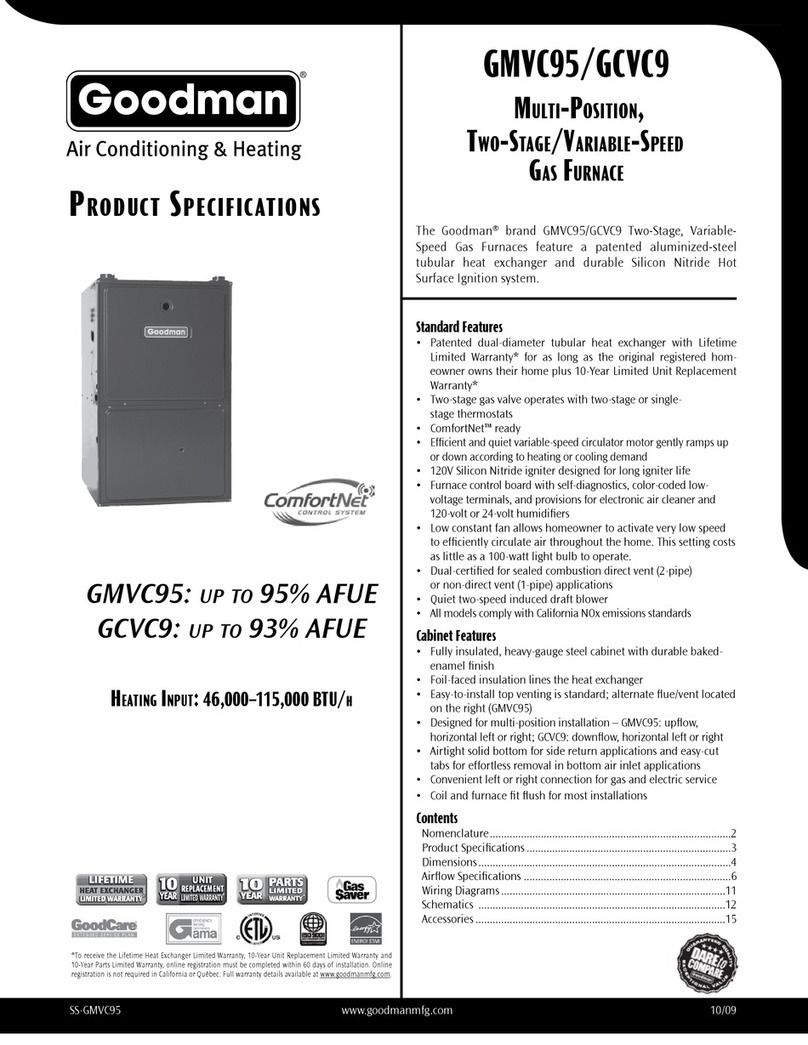
Goodman
Goodman ComfortNet GMVC95 manual
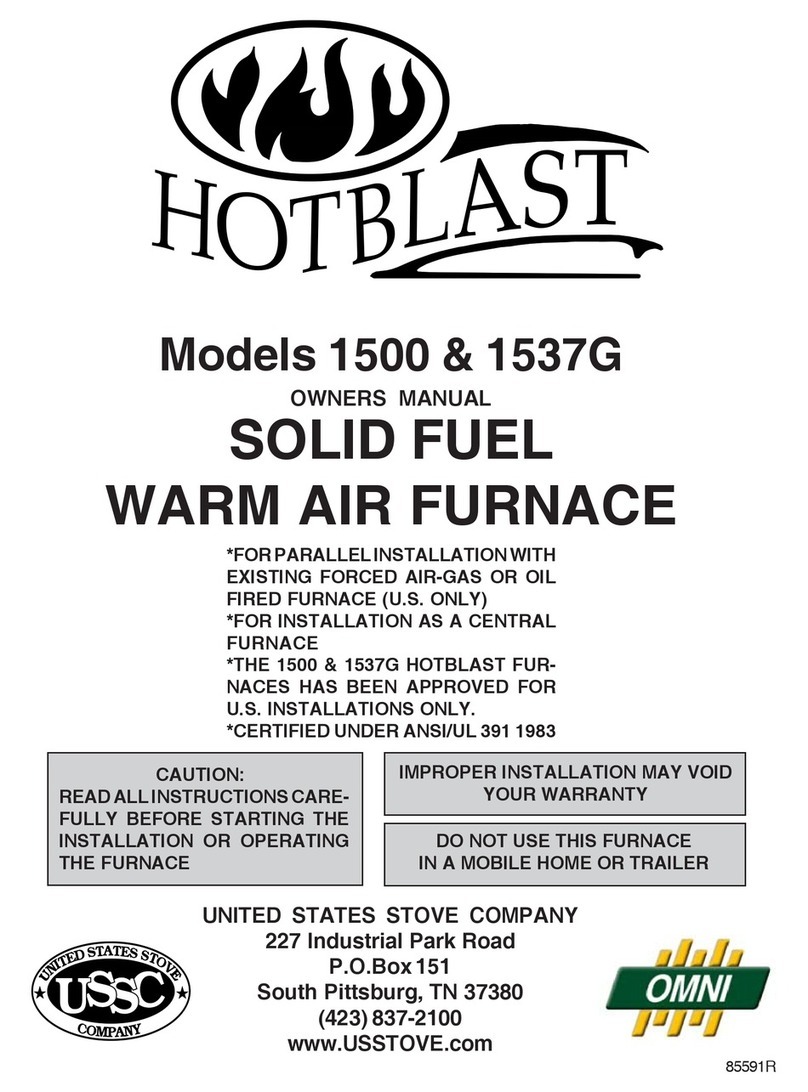
USSC
USSC Hotblast 1500 owner's manual
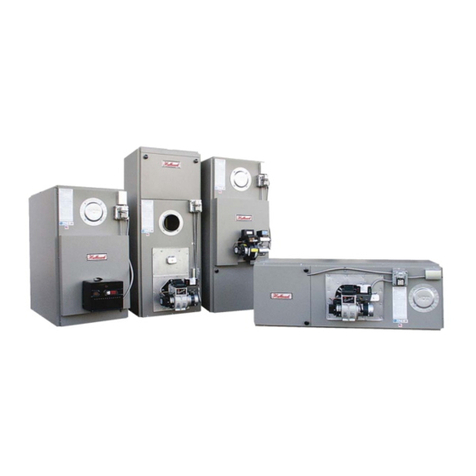
Hallmark
Hallmark Variable Speed 2 Stage Installation and operation instruction manual

Intertherm
Intertherm M7RL Series user manual

Goodman
Goodman GMV9 Installation & operating instructions
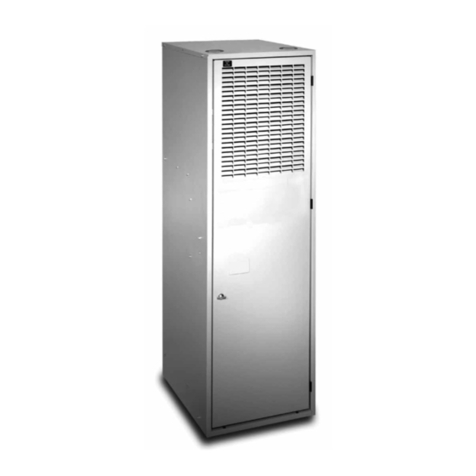
Nordyne
Nordyne CMF95 Series installation instructions
